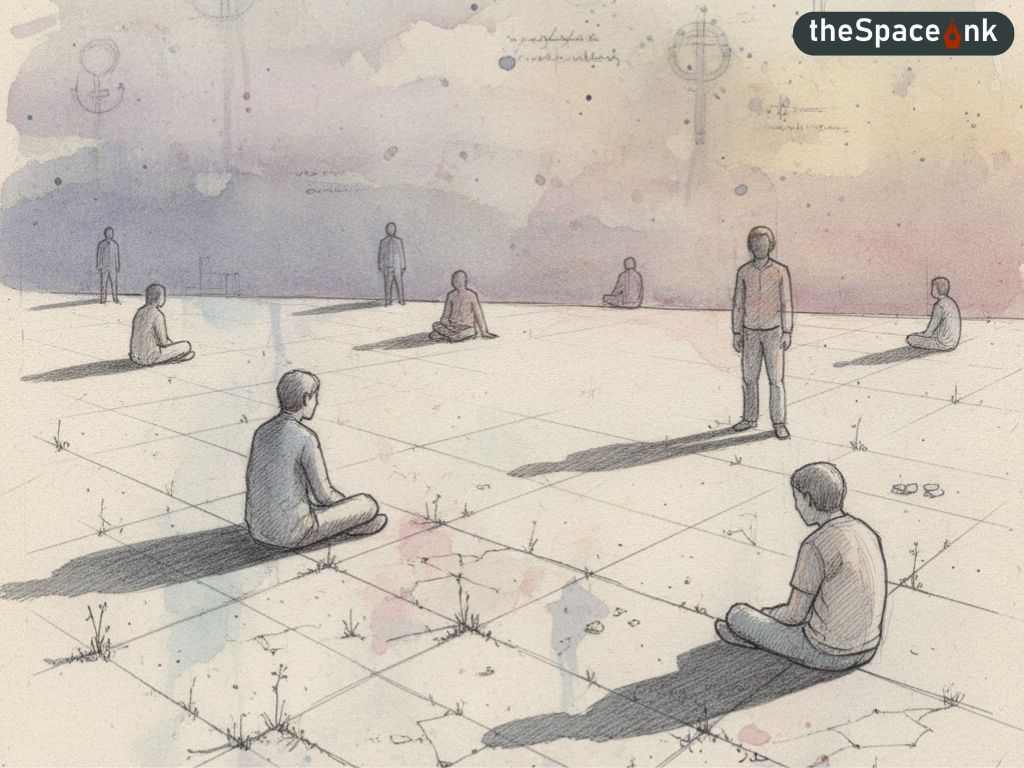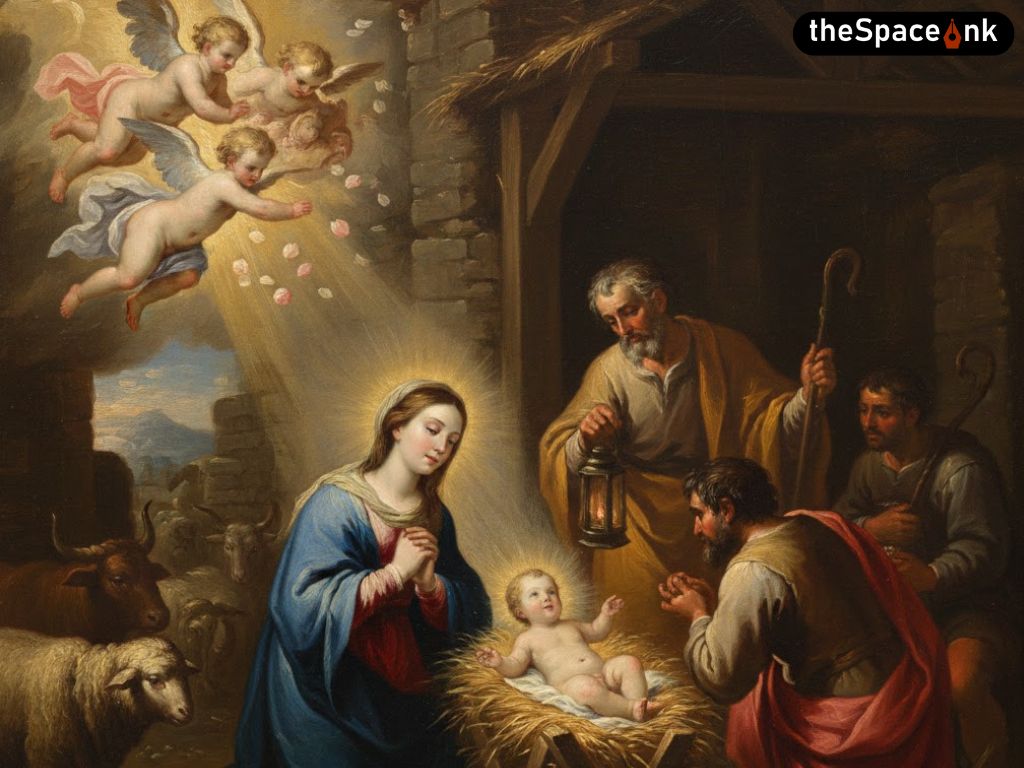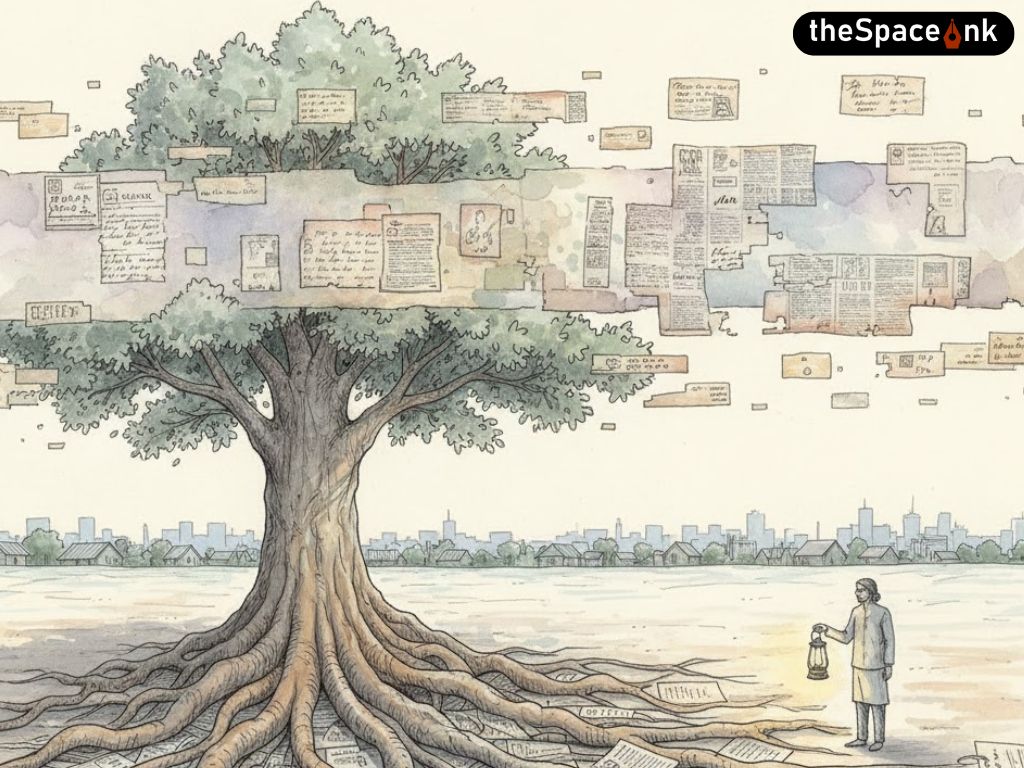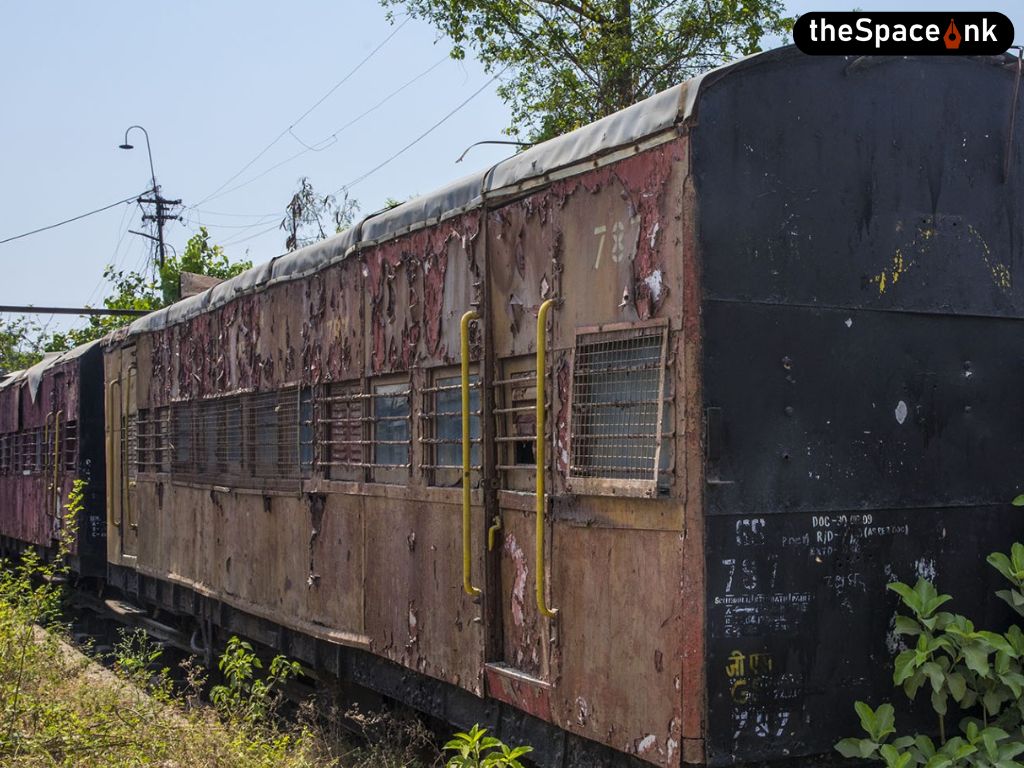K.G. Subramanyan, popularly known as “Manida” or “Mani Sir”, depending on the location of address, was born in 1924 in Mahe, a small town in Kerala, populated largely by Tamilians and, at the time, governed by the French.
In this, his centenary year, I would like to briefly attempt recounting Manida in his various effulgences – both structured and unstructured, through his pedagogy and practice.

I
Unlike the general understanding of pedagogy as standard syllabic planning, in the Santiniketan of his student years (1943-46), the process of knowledge was flexible. His teachers in Kala Bhavana were the principal Nandalal Bose and his two lieutenants – Benode Behari Mukherjee and Ramkinker Baij, from whom Subramanyan drew enormous energies to start his journey as an artist and a pedagogue. His intimacy with these maestros, their playfulness and deep understanding of life and art certainly shaped his pedagogic stance.

Having taught almost four generations of pupils, Manida is eponymous with teaching, his prominent disciples including, among others, Jyoti Bhatt, Gulam Mohammed Sheikh, Nilima Sheikh, Jyotsna Bhatt and Vivan Sundaram.
When approached by students seeking guidance, Manida would first assess their strengths. While perusing their work, he would enter into conversation with them and then the advice would come, activated by quick sketch demonstrations on paper supplied by the recipients themselves, sometimes with appropriate anecdotal accompaniments.

He had the ability to address the crux of the matter with his succinct analyses; the briefest of instructions, the subtlest of insightful guidance would often be wrapped in narratives interspersed with humour. He taught by drawing parallels, through metaphors, references and examples. His critiques, much like his art, sparkled with natural wit and, occasionally, bristled with the bite of his sarcasm. They were not for the faint-hearted. An initial vacuum created by the blast of wisdom would gradually fill with comprehension, as the recipients found their context and succeeded in apprehending the kernel. A certain amount of reflexivity would allow for the understanding of the advice.
II
K.G. Subramanyan’s was a multifaceted creativity; he was a painter, muralist, sculptor, designer, writer, poet, philosopher, art thinker and educationist, and by his own description, an artist-activist. His oeuvre primarily comprises his paintings on canvas, paper and glass, and his murals.
The main body of Manida’s murals are in Baroda (in Jyoti Ltd. and Faculty of Fine Arts, MSU) and Santiniketan (Design Studio, Sculpture Studio and Mastermoshai’s Studio in Kala Bhavana). He carried with him the essence of the mural movement in Santiniketan that was initiated by Nandalal Bose and his colleagues. These masters’ murals, though conceived by them, evolved as community projects. Manida was part of the movement in the 1940’s, and incidentally, was involved in the execution of one of the most important modern Indian murals, Medieval Saints, designed by Binode Behari Mukherjee for the Hindi Bhavana.

To dwell a little on Manida’s own murals in Santiniketan – they were voluntary initiatives, the earlier ones with his personal investment. In keeping with the tradition, they were completed with the participation of students and staff members. Both, the processes and the products were the results of joyous engagement. Consequently, their coming to being exuded festivity – in his unique phrasing – the ‘Magic of Making’. Completed in the years between 1988 to 2011, these were conceived around various buildings in Kala Bhavana, the fine art institute of the university. The earliest is a sand-cast cement mural related to the origin myths, depicting three mythological deities with recognisable iconography – Kamale-Kamini in the centre, flanked by Ganga and Yamuna. The relief wall is fronted with sculptures of the makara, turtle and lotus – motifs related to the three. The design studio building has hosted two different black-and-white murals executed in two different decades, 1990 and 2009, by Manida.
The first version was purposefully done in material expected to register the natural alterations of time. The later, a more durable one replacing the previous, has a plethora of masterfully rendered images of plants, trees, animals and mythological figures – is a vibrant, living field where the real and the imaginary seem to cavort.
Manida’s final mural is a stoneware tile work that, appropriately, wraps the ‘Mastermoshai’s Studio’ – the iconic building in the centre of Kala Bhavana named after Nandalal Bose or ‘Mastermoshai’ as he was fondly called, and that he shared with his illustrious colleagues. The earth-coloured, painted tiles bear white decorative motifs, textures and linear patterns inspired from nature, interspersed with calligraphic writing – that are selective quotes from reflections on art by Rabindranath Tagore, Abanindranath Tagore and Nandalal Bose. The mural simulates white ‘alpona’ on mud walls, transforming the sensation of the brick building. At the time of Manida’s first black and white mural, I had asked him for his reason for undertaking the project, he had answered in his mild but incisive tone, “A mural does surgery to the environment in which it exists”.

The earlier murals created in Baroda had a sense of their social dynamics. For instance, the murals at Jyoti Limited depicted factory workers undertaking various tasks. Here, the artist’s Gandhian socialist sense of context was at work.
III
K.G. Subramanyan is designated as an eclectic artist by many critics, an artist who played with his stylistic inventory, culled from multiple traditions, ancient and modern
That is also a reading on many of the Santiniketan artists, especially the stalwarts, who never identified style with either persona or ideology. As his teachers, Nandalal, Benode Behari and Ramkinker, Subramanyan too, experimented with a variety of materials, from wood to leather to metal and terracotta, along with usual and unusual painting surfaces like Nepali paper, perspex and glass, as well as multiple techniques. His work is also rich in usage of literary references from Rabindranath, Abanindranath and the global humanist literary contact points like Eliot and Yeats. Subramanyan effortlessly navigated between mediums, techniques and styles as it suited him; sometimes coming forth with the folkishness of Molala terracottas, or the narrative and iconicity of temple terracottas, sometimes, drawing elements from the Kalighat Pat or the works of Bengal folk painters, or from Thanjavur glass paintings, at others, referencing Rajput or Mughal miniatures.

I would like to selectively touch upon two series of his paintings that are of particular significance; Fairy Tales of Purvapalli (1986, oil on glass) and Oxford Fairy Tales (1989, paintings on perspex), based on his experiences in Purvapalli – his locality in Santiniketan, and Oxford, respectively.
Both reverse painting sets, they are reveries and secondary, more distant references to events and things, capturing an overall essence of stay in a location and familiarity with the site involving exploration, exchange and mutuality. They are playful, sometimes sardonic, subversive commentaries on the realities and hypocrisies of contemporary times, in guise of fables. A painting titled, ‘Revery of an Army Man’s Wife’ from the Purvapalli series, is a tongue-in-cheek narrative showing a pretty, boisterous-looking woman staring into the distance, as if ruminating about a rosy past. The artist’s intervention into these narratives was almost always entangled in the moral reception aspects of the images and the representations.

The Oxford series are memorable for me not just because of their merit, but because I had the good fortune to a private viewing by Manida himself. Among the paintings I saw that day, many had the imagery of an old, emaciated figure – resembling Inayat Khan from a Jehangiri miniature by Balchand – in the foreground, looking in, as if observing the phantasmagorical reality of the Oxford of Manida’s experience, in proxy. The painting titled, ‘Ethiopian Nativity’, depicted a black mother, resembling Durga, holding a dead child. Ethiopia was struggling with one of the worst famines at the time, and the Western world, led by some of their best musicians, had organized a musical fundraiser to address the food crisis of Ethiopia. The contradiction of means and ends (the crux of Gandhian politics) touched base with the visual culture of this eponymous eclectic, who belonged to the two worlds of visions and their betrayals. The modernist promises of a burgeoning nation and its testament were betrayed. This was addressed by the artist in this work.

The viewing at the Purvapalli house of the artist was transformative, in the way that it coaxed me to look at the “real” through a different lens.
All images are by the author and Sanjeet Chowdhury
Anshuman Das Gupta , born on the 14th of July,1967, Kolkata, India; Did PhD from Goldsmiths, London University, Visual Cultures Department. Graduation in Art History from Kala Bhavan, Visva Bharati University, Santiniketan, and MA in Art History, M.S from University of Baroda in 1990 and 1992. Completed film appreciation course from FTII, Pune, 1993; Research fellow at the MSU, Baroda from 1992 to 1997; Joined Santiniketan In 1997. His recent curatorial ventures include the Ramkinkar Baij Centenary exhibition (2006), Santiniketan. Co–curator of ‘Santhal Family: Positions Around an Indian Sculpture’ Antwerp, (2008); Bauhaus Imaginista exhibition (2019-20) Berlin; Chief official curatorial researcher from India, (Book) 2019. As a writer, he contributed to The Marg volumes on modernist Institutions and on contemporary Indian Sculptures and the book titled 'Curating Subjects', edited by Paul o’neill; The Curatorial. published by Bloomesbury, London (n 2013), and in Bauhaus Imaginista web journal and the book/ catalogue published on the occasion in 2019 ( Thames and Hudson), London. Currently, he is part of the inter-continental long term research project titled “Taj of the Raj”, Hosted by Syracuse and Cornell University, US.







